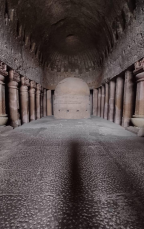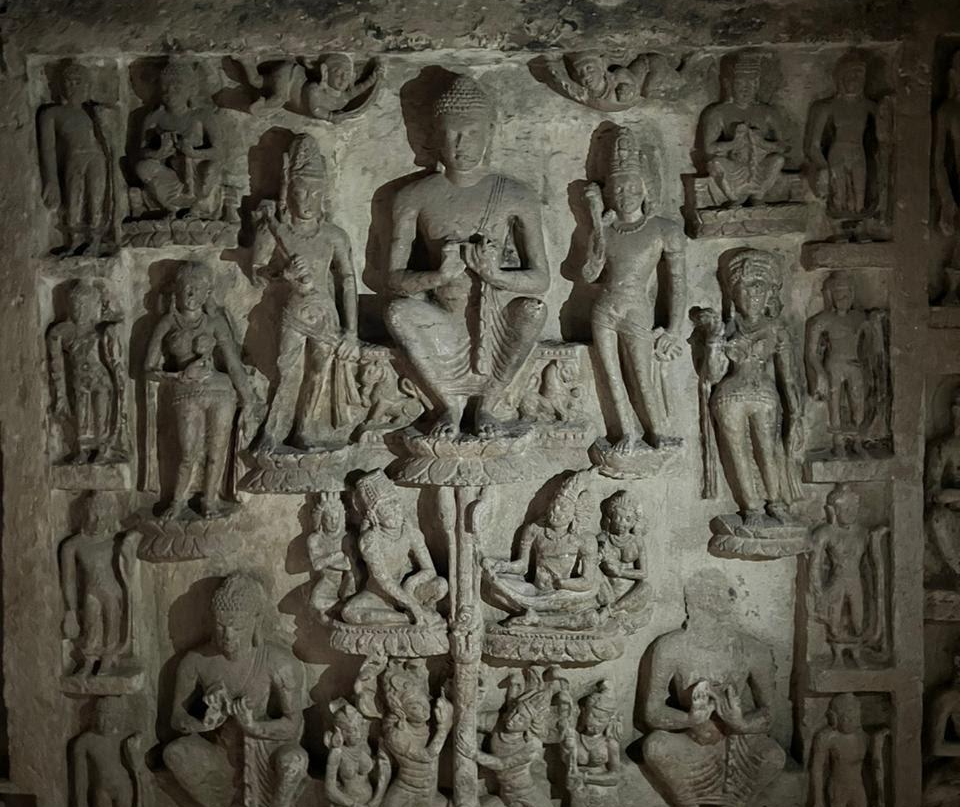THE IMPRESSIONS OF GAUTAMA AT KANHAGIRI
The Kanhagiri also called the Krishnagiri or more commonly known as the “KANHERI CAVES”, is one the largest system of once-living Buddhist caves in the western part of India.They get their name from lord Krishna himself, where Krishna or Kanha means Black and Giri meanscaves. Hence Black Mountain Caves originated in the first century C.E. and lived through the rise and downfall of Buddhism in our country. They were first used as religious centers, followed by turning them into educational centers and finally, during the downfall, as commercial centers. Speaking just about the caves in terms of architecture and construction, everything from the rooms all the way to the steps leading to the higher levels has been rock cut, i.e. carved out the rocks present there without altering the topography very much. More than 100 caves are present here; hence it is called the largest center of Buddhism in Western India.

The caves’ design and drainage system are so intricate that it seems like a modern age pattern. There are multiple caves just for water storage, and it is said that these caves could hold enough water for all the pilgrims and monks throughout the scorching summer.

CAVE 3, called the Chaitya Hall, has a seven-m-long Buddha at the entrance having a drape over his arm. There is a hall inside that is 28 m long and 13 m wide with a stupa at the end with pillars supporting the long hall on either side and space for the pilgrims in the middle to sit and meditate while facing the stupa.



Speaking of the Kanheri as a whole, they can be called a Mahavihara, meaning “a big Buddhist monastery”. Although to a lot of people, the most exciting fact might be the scale of this monastery, for me, it is the number of engravings and types of sculptures found in all of these caves.
One such cave is Cave 67, which, as seen from the inside, can be regarded as a big group meditation hall surrounded by four walls with engravings of the Enlightened one or, as we all commonly know him, Buddha. These engravings are of the famous Sravastavi Miracle, in which Buddha made a mango tree sprout in a single day. Here, Buddha is on a lotus with the Bodhisattvas Padmapani and Vajrapani on either side, also standing on a lotus. Multiple panels are present here, and it looks like the larger ones were carved first while the smaller ones were fitted around it.


A trinity panel (trinity meaning three, i.e. a panel of 3 people) can also be seen in the panels set up at Cave 67, where Buddha is in the centre with a Bodhisattva on either side. Another interesting depiction is in Cave 67, where, in the passageway on one side, is the story of Sumedha and the Dipankara Buddha. Sumedha is said to have been a hermit who laid his hair on the ground so the Buddha could cross a puddle without soiling his feet. Sumedha was believed to be none other than Gautama himself in a previous birth.

One of the more interesting panels is in Cave 90, which, at first sight, appears to be a Sravasti miracle. However, there are four figures instead of two under the lotus. Looking closer, it is evident that the two figures at the lowest level are the Nagas, supporting the lotus. Among the other two pairs of figures above them, one appears to be Shakra, or Indra, by his crown, and behind him is his Vajrapurusha, with folded hands and the emblem of the Vajra on his crown. The other pair appears to be a Gandharva and an Apsara. This panel is believed to depict Shakra’s visit to the Buddha.
Other than these, there are also engravings of certain animals present throughout the caves, some under the pillars while others on the walls and some carved into the stupas. The first prominent one is the elephant; elephants are generally wise creatures, and probably the wisest of them all are shown bowing down at the feet of Buddha, showing that there is a deity existing who is wiser than them. The second one is a lion, representing courage, royalty and valour, and a lion at the feet of the Enlightened one shows the respect given to him.


Some Terms Mentioned In The Article:
1. Bodhisattvas: Bodhisattvas are spiritually heroic persons that work to attain awakening and are driven by great compassion.
2. Padmapani: Bodhisattva, as the lotus-bearer Padmapani, was a favoured form of
Avalokiteshvara, the embodiment of Buddhist compassion. His identifiers are the lotus (Padma) held in his left hand and the small figure of the Buddha Amitabha atop his head.
3. Vajrapani: Vajrapani, the “holder of a thunderbolt” (vajra), shares his origins with the Vedic deity Indra, the god of storms. Early in Buddhist iconography, the thunderbolt scepter assumed an independent meaning associated with clarity of pure thought leading to enlightenment.
4. Sumedha: Sumedha Buddha is the fourteenth of twenty-seven Buddhas who preceded the historical Gautama Buddha.
5. Dipankara Buddha: According to some Buddhist traditions, Dīpankara was a Buddha who reached enlightenment eons before Gautama Buddha, the historical Buddha.
6. Indra: The god of rain and thunder.
7. Vajra Purusha: Typically means a personified thunderbolt, which was a weapon used by Indra
himself.
8. Gandharva: A Gandharva is a member of a class of celestial beings in Dharmic religions, such as Hinduism, Buddhism, and Jainism, whose males are divine performers such as musicians and singers, and the females are divine dancers.
9. Apsara: An apsaras or apsara is a member of a class of celestial beings in Hindu and Buddhist culture. They are originally a type of female spirit of the clouds and waters, who later plays the role
of a “nymph” or “fairy”.
About Author:
Archit Sawant is a student who loves exploring nature, travelling, gaming and learning new things. He is a melophile and composes his own songs too. He likes telling the world about his views through his writings and discussions and hopes they inspire people. He always looks out for intense discussions and debates that help him understand other people’s views.



